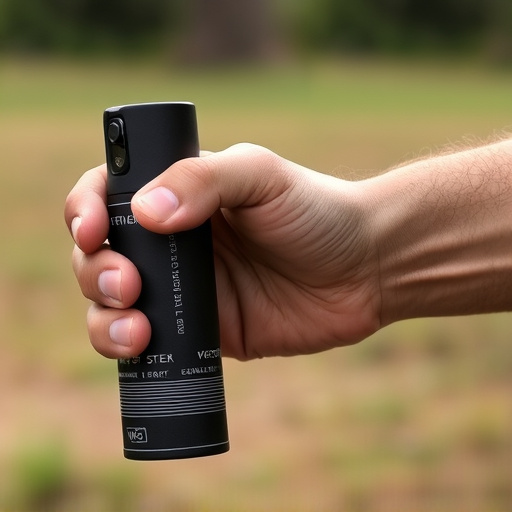Pepper spray effectiveness is heavily influenced by wind, with tailwinds extending range and headwinds potentially causing spray to blow back. To maximize accuracy, officers are trained to aim slightly into the wind. Safety precautions include considering wind direction to minimize risks, proper gear use, regular canister inspections, and aiming downwind when deploying. Understanding optimal wind conditions for pepper spray deployment is crucial for both safety and efficacy.
“Uncovering the power of pepper spray, this comprehensive guide delves into its composition, effectiveness, and strategic deployment. From understanding the intricate mix of capsaicin compounds to exploring factors like range and accuracy in various weather conditions, we equip law enforcement with crucial insights. Key topics include safety precautions, best practices for optimal use, and environmental considerations, especially pepper spray wind direction tips for precise control. Navigate these tactics to ensure mission success.”
- Understanding Pepper Spray Composition and Effectiveness
- Factors Influencing Pepper Spray Range and Accuracy
- Safety Precautions and Best Practices for Law Enforcement
- Environmental Considerations and Wind Direction Tips
Understanding Pepper Spray Composition and Effectiveness
Pepper spray, a potent force in law enforcement and self-defense, is a compound designed to temporarily incapacitate an individual by provoking a severe irritation response in the eyes, nose, and respiratory system. Understanding its composition is crucial when considering its effectiveness, especially when factoring in the pepper spray wind direction tips. Key ingredients often include capsaicin, the active component derived from chili peppers, and various lubricants for improved dispersion and skin contact.
The wind plays a pivotal role in how pepper spray performs. In ideal conditions, aiming into the wind allows for maximum range and coverage, as it carries the spray directly towards the target. Conversely, spraying against the wind can reduce its effectiveness due to the spray being blown back onto the user or breaking up before reaching its intended mark. Knowing this dynamic is a valuable pepper spray wind direction tip that can significantly impact outcomes during tactical situations.
Factors Influencing Pepper Spray Range and Accuracy
The range and accuracy of pepper spray are significantly influenced by various environmental factors, with wind direction being one of the most critical. Pepper spray is designed to create a cloud of irritants that can temporarily disable or disorient targets, but its effectiveness depends on proper application. When using pepper spray, understanding the wind direction tips becomes essential for optimal performance. Tailwind conditions, for instance, can significantly enhance the range and spread of the spray, allowing it to travel farther than in still air or headwind scenarios. Conversely, headwinds may cause the spray to blow back towards the user, reducing its effectiveness and posing a potential health risk.
To ensure maximum accuracy, officers are trained to consider wind speed and direction before deploying pepper spray. In calm conditions, a direct burst can be effective at close ranges. However, in windy environments, adjusting the angle and timing of the spray discharge becomes crucial. Proper technique involves aiming slightly into the wind to allow the spray particles to float along its path, increasing the chances of hitting the intended target. By accounting for these factors, law enforcement can maximize the effectiveness of pepper spray while minimizing risks associated with misapplication.
Safety Precautions and Best Practices for Law Enforcement
When deploying pepper spray, law enforcement officers must consider the wind direction as a critical safety precaution. It’s essential to assess and account for the breeze to prevent the agent from blowing back onto the user or bystanders. Officers should aim for downwind positions, ensuring the spray dissipates away from them and any non-target areas. This simple tip can significantly reduce the risks associated with pepper spray use, as it minimizes direct exposure and helps maintain the integrity of the force’s tactical strategy.
Best practices also dictate that officers undergo regular training to master deployment techniques. This includes learning how to activate the spray correctly while maintaining a safe distance. Officers should be equipped with proper protective gear, such as goggles and respirators, to safeguard against any residual effects of the compound. Additionally, keeping pepper spray canisters easily accessible and ensuring they are regularly inspected for damage or malfunction is vital. These precautions collectively contribute to effective law enforcement while upholding the safety of officers and civilians alike.
Environmental Considerations and Wind Direction Tips
When using pepper spray, environmental considerations are crucial for safety and effectiveness. Wind direction plays a significant role in determining how the spray disperses and where it lands. For optimal results and minimal exposure to bystanders or sensitive areas like water sources, it’s essential to account for wind speed and direction before deployment.
If the wind is blowing away from you and your target, it can help contain the spray within a smaller area, reducing its impact on surrounding environments. Conversely, if the wind is coming from behind or parallel to your position, be cautious as the spray could potentially reflect back towards you or spread laterally, increasing risk to nearby individuals not involved in the situation.
Pepper spray, a powerful tool for law enforcement, relies on understanding its composition, range, and environmental factors like wind direction. By grasping these aspects, officers can ensure safety precautions, enhance accuracy, and use this compound effectively in various scenarios. When deployed strategically, pepper spray can disrupt and de-escalate situations promptly, making it an invaluable asset in modern policing. Remember, the right Pepper Spray Wind Direction Tips can make all the difference in successful outcomes.
